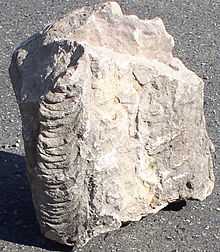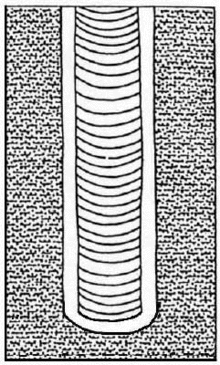Diplocraterion
| Diplocraterion | |
|---|---|
 | |
| Diplocraterion burrow (at left) from the Silurian-age Tuscarora Formation at Bald Eagle Mountain, Centre County, Pennsylvania. Specimen is ~22cm high. | |
| Trace fossil classification | |
| Ichnogenus: | Diplocraterion |

Sketch by Richter (1926) showing spreite in a Diplocraterion parallelum burrow.
Diplocraterion is an ichnogenus describing vertical U-shaped burrows having a spreite (weblike construction) between the two limbs of the U.[1][2] The spreite of fainter U-shaped traces appears above and below the final tunnel, made as the organism moved up and down through the sediment.[3] Diplocraterion is the classic example of an "escape burrow", where the organism moves upward during high-sedimentation rates, creating spreite below it, in order to prevent the burrow entrance from being buried.
See also
References
- ↑ Richter, Rudolf (1926). "Flachseebeobachtungen zur Paläontologie und Geologie. XII-XIV". Senckenbergiana 8: p. 200–224.
- ↑ Fursich, F.T. (1974). "On Diplocraterion Torell 1870 and the significance of morphological features in vertical, spreiten-bearing, U-shaped trace fossils". Journal of Paleontology 48 (5): 952–962. JSTOR 1303293.
- ↑ Cornish, F.G. (1986). "The Trace-Fossil Diplocraterion: Evidence of Animal-Sediment Interactions in Cambrian Tidal Deposits". PALAIOS 1 (5): 478–491. doi:10.2307/3514630. JSTOR 3514630.
Further reading
- Šimo V. & Olšavský M. (2007). Diplocraterion parallelum Torell, 1870, and other trace fossils from the Lower Triassic succession of the Drienok Nappe in the Western Carpathians, Slovakia". Bulletin of Geosciences 82(2): 165-173. doi:10.3140/bull.geosci.2007.02.165.
| Wikimedia Commons has media related to Trace fossils. |